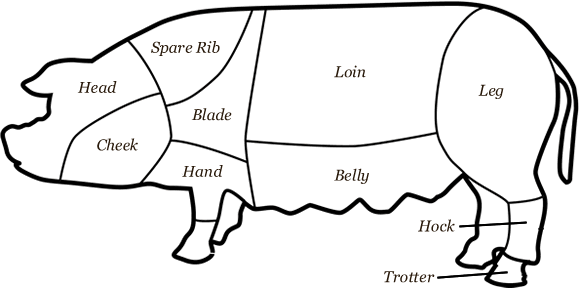Butchering Pigs
If you are using a butcher, take the opportunity to discuss exactly what you want him to do. If, like us, you're selling meat on, ask your customers first. A family of two probably won't want large, 3-4lb joints of pork, and similarly a family of 6 won't want 1lb joints.
A side of a pig comprises:
Head
This can be used to make brawn. The brains are edible, if you fancy it. The cheeks are sometimes taken as a separate cut and are renowned for being tender and tasty if cooked correctly.
Spare Rib
This is the top part of the shoulder, which contains the blade bone. It can be boned out and rolled as a roasting joint OR shoulder steaks OR made into collar bacon OR cured to make shoulder ham OR used for sausages / pork mince OR cubed for casserole pork.
Hand
This is the bottom part of the shoulder and upper part of the front leg. On a large bacon pig, this is a substantial piece of meat that can be cured as ham. Otherwise, it can be used for sausages, pork mince or cubed for casserole pork.
Loin
This is the back of the pig, from behind the shoulder almost to the tail. On a large bacon pig, the loin is a considerable length. All or part of the loin can be cured for back bacon or cut into roasting joints or pork chops. The tail end of the loin gives pork chops with least bone.
Belly
This is from the underside of the pig and is almost as long as the loin. It can be boned and rolled for roasting OR skinned and boned and cured for streaky bacon. The thick end of the belly – the first third from the head end – is best for roasting; the remaining two thirds is best for streaky bacon.
Leg
The leg is the part of the pig traditionally cured for ham. If you don’t want to cure the pork, the leg can be cut in 2 or 3 leg (gigot in Scotland) joints, either boned or bone in.
Trotters
The four feet. Front trotters are normally longer than back ones. The upper part of the trotter is sometimes butchered separately as a hock or hough, also known as pork knuckle or shank.
Cuts of Pork
These cuts are shown on this diagram:

Blood and offal
You may or may not be able to get blood, for black pudding, and offal (liver, kidney, heart) back from the abattoir. If you want it, ask. We’ve never been able to, but we’ve got along just fine without.
Also discuss with your butcher whether the meat will be picked up fresh or frozen and what sort of packaging will be used. Some packaging disintegrates in the freezer, so the meat may suffer from freezer burn. Vacuum packing is probably the best method of packaging.
If you want your butcher to make sausages or cure bacon, he will charge you accordingly. Remember, not all butchers cure bacon.
Sausages are expensive to make; additional time is required for the mincing, mixing and filling the skins and the skins are an additional cost, so your butcher will charge extra for this service.
Ask him to pack the sausages in manageable packs, especially if you are picking the meat up already frozen - a 27lb pack of frozen sausages is awfully difficult to handle.
- Previous « Processing and selling pig meat
- Next Pig costs »

About Rosemary Champion
Rosemary lives on a 12 acre smallholding in Angus, in the east of Scotland, where she keeps Ryeland Sheep, Shetland cattle and assorted poultry. She was destined to be a smallholder from an early age.
Further Reading
 Pigs: A Guide to Management Neville Beynon |  Pig Keeping (Countryside Series) Richard Lutwyche |  Small-Scale Outdoor Pig Breeding Wendy Scudamore |  Pig Ailments: Recognition and Treatment Mark White |  Know Your Pigs Jack Byard |
Smallholding shop
When you click links below and make a purchase, this may result in this site earning a commission from eBay.

Pig / cattle Weigh Tape
Weigh tape for Pigs. A simple… from £6.32 + p&p

Pig Breeding/Service Record Book
Pre-printed record… from £6.00 + p&p

Pig Ringer
Pig Nose Ring Applicator.… from £8.45 + p&p

Pig Board Large 120 x 76
120cm x 76cm Large Pig board. … from £40.56 + p&p

















